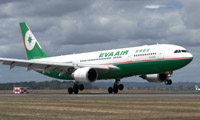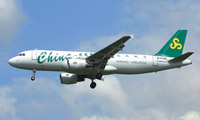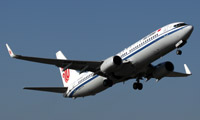Main Story
SHRINKING THE AVIATION DIVIDE
Air links between China and Taiwan are racing towards normality. A proposed new policy development between China and Taipei, little noticed beyond the region, could make Taiwan an integral hub in Greater China’s commercial skies.
April 1st 2014
In late February, Chang Hsien-yao, vice chairman of Taiwan’s semi-official Straits Exchange Foundation (SEF) returned to Taipei after attending high-level talks between the organization and the Beijing-based Association of Relations Across the Taiwan Straits (ARATS) with good news. Read More » He told Taiwan’s premier, Jiang Yi-huah, and senior officials, that Beijing was prepared to discuss altering Taiwan’s status to a transit point for Mainland Chinese air travelers.
Until the February meeting, with its breakthrough discussions, Beijing had refused to entertain such an idea. No agreement has been reached to date, but Chang believes serious discussions on the policy shift could begin as early as next month.
 |
| 'For Mainland Chinese passengers travelling from second tier Mainland cities to Europe, North America and Southeast Asia, Taiwan is a better transit hub' |
| Austin Cheng President of EVA Airways |
If the transit rule is revised, the new policy will be a massive boost to Cross Strait air travel and to Taiwan’s major hub, Taipei’s Taoyuan International Airport, now being upgraded to a US$16.5 billion aerotropolis that includes an expanded airport and a free trade zone encompassing an industrial park.
At present, Taiwanese travelers can transit in China on their way to third countries, but China does not allow its nationals to follow the same policy through Taiwan. The rule disadvantages Taiwan’s airlines and boosts traffic for several of their competitors.
China enforces the ban by refusing to grant exit visas to Mainland travelers if a transit stop in Taiwan is part of their travel itineraries. As a result, the fast increasing numbers of Mainland travelers travel via other cities in China or several Asian countries, including Japan and South Korea, to the Asia-Pacific and The Americas.
Tawainese airlines estimate cancellation of the transit ban would increase passenger numbers stopping in Taipei by 20% to 30%. They said the Taiwan transit option would be very attractive both to Chinese citizens and the nearly one million Taiwanese China-based expatriates.
Austin Cheng, president of Taiwan’s EVA Airways, told Orient Aviation last month: “There are potentially 49 Cross Strait routes to destinations in China. EVA Air and China Airlines (CAL) both operate convenient global networks. For passengers traveling to Europe, North America and Southeast Asia from China’s second tier cities, Taiwan is a better transport hub.
“If they fly directly to Taiwan, travelers can avoid the crowded hubs of Beijing and Shanghai and enjoy the advantages of a gateway where people speak the same language, unlike airports in Japan or Korea.”
| 'If they fly directly to Taiwan, travelers can avoid the crowded hubs of Beijing and Shanghai and enjoy the advantages of a gateway where people speak the same language, unlike airports in Japan or Korea' |
EVA operates 116 flights a week to 26 Mainland cities. Cheng said the carrier provides onward connections on 45 flights to six major cities in North America. “Since 2010, we have promoted Taiwan as the ideal transit hub for passengers traveling from North America to China,” Cheng said.
China Airlines’ (CAL) vice president of corporate communications, Jeffrey Kuo, said the Taiwanese flag carrier airline operates 113 flights a week to 28 destinations between Taiwan and China. Under the recent allocation of new services, CAL will begin flying to Changchun, Yaitai, Heifei and Suzhou, which will increase the number of CAL’s cross strait flights 135 each week. Kuo said if the transit clearance is approved, advantageous markets through Taiwan would include passengers from second and third tier southern Chinese cities destined for North America via Taiwan and passengers from eastern and northern second and third tier cities flying onto New Zealand and Australia via Taiwan.
“Actual circumstances will depend on the profitability of the destinations,” he said. “If Taiwan can operate as a regional hub for passengers of second and third cities in China, there will be greater operational stability. And, if China says yes to Mainland Chinese transitting through Taiwan to a third destination, CAL’s revenue will clearly increase.”
“Our strategy has proven to be very effective with North American travel agencies. The high levels of service, convenience and comfort we offer can surely extend to more passengers from China if a Cross-Strait transit policy is adopted.” Potential travelers include those bound not only for the U.S., but to Australia and regional leisure destinations.
Spokesperson for Taiwan’s TransAsia Airway, vice president of corporate affairs, Alison Kao, told Orient Aviation the country was sitting in a “great location” in the Asia-Pacific. “Whether you are travelling to North or South Asia, it only would take two to four hours for onward travelers to use Taiwan. The superior location gives Taiwan a strong claim to be major transit center for people from China.”
 |
| 'We want to fly to more cities on the island [Taiwan] besides Taipei and Kaohsiung, but we can’t due to current limits ' |
| Spring Airlines Shanghai-based low-cost carrier |
TransAsia plans to expand its network to the U.S. or Europe in the near future, she said. “If this transit agreement happens, it will bring us more passengers as well as revenue. We are looking forward with optimism to an agreement,” Kao said.
Taiwan’s airlines believe the country’s planned aerotropolis could match Hong Kong, Singapore and Seoul as an aviation hub when the project is completed in 2020. Clearance to act as a transit point is so critical that Taiwan’s transportation minister, Yeh Kuang-shih, recently told a local radio station that Taiwan has poured nearly all of its resources into its aerotropolis development and the country “will be through” if it does not succeed.
“The project will be the nation’s most important one in the next four or five decades. If we fail, I am afraid we are going to have to say: ‘Bye bye, Taiwan’,” he said. More than 40,000 people have been relocated to develop the facility, which is planned to cater for 60 million passengers and 4.5 million tonnes of cargo by 2030.
While airlines are excited about the potential breakthrough, nothing comes for free when it involves negotiations between China and Taiwan. The quid pro quo of any transit agreement would likely hinge on agreement by Taipei to abandon another pivotal rule governing cross strait flights.
At present, carriers flying between Mainland China and Taiwan are not permitted to fly directly across the Strait via a median line. Each flight must either detour over the South China Sea or the East China Sea, routes that Taiwan has insisted on maintaining for “security reasons”. China wants that rule dropped. The rule change is supported by airlines who will save millions on operating costs, particularly fuel, if the rule is eliminated.
 |
However, industry insiders have said that if Beijing insists on this rule change in exchange for a deal on transit passengers, it could derail negotiations. Chang Hsien-yao, deputy chairman of the Straits Exchange Foundation (SEF), Taiwan’s agency for cross strait negotiations, said in March there was “no room for negotiations” on the median line rule. “The two issues are separate. They will not be bundled together in negotiations,” he said.
If the breakthrough is approved, its impact on passenger demand will be spectacular, even in a market that already is booming. A record nine million visitors traveled across the Taiwan Strait in 2013, a million more than in 2012.
Mainland Chinese visiting Taiwan reached 2.85 million last year, an increase of 10% over 2012. Chinese travelers outnumbered Japanese visitors to Taiwan in 2013 by almost two to one.
The numbers will rise again this year. Weekly flights allowed between the Chinese Mainland and Taiwan, which increased from 616 to 670 a week in 2013, will jump to 828 this year. Between them, Mainland and Taiwanese carriers connect to 10 airports in Taiwan and 54 airports in China. During the last Lunar New Year holiday period (from January 17 to February 14) restrictions on flight numbers were removed, except at congested airports including Taipei International (Songshan) Airport and Shanghai Hongqiao International Airport. Apart from scheduled services, 30 charter flights operate across the Strait each month.
Another development that may influence Mainland China on the transit rule change is a government policy to encourage establishment of more Mainland low-cost carriers. Several budget airlines are on the drawing board and will soon be ready to join the handful of LLCs already flying.
Most of the budget startups will have their sights on Taiwan. Last October, Shanghai-based Spring Airlines became the first Mainland budget airline to fly directly to Taiwan. “We want to fly to more cities on the island [Taiwan] besides Taipei and Kaohsiung, but we can’t due to the current limits. We also want to invest and set up a company in Taiwan,” said Spring Airlines spokesman, Zhang Wuan.
 |
| 'Forty five per cent of travelers still transit through other regions on their way to China. So we would like to increase flight frequencies to China' |
| Sun Huang-hsiang Chairman China Airlines |
The surge in demand on Taiwan-China routes is a consequence of expanding economic co-operation between the Beijing and Taipei. Recent statistics show the trade volume between the China and Taiwan reached $197.2 billion last year, a 16.7% jump year-on-year. Beijing approved 1,804 Taiwan sourced projects for investment on the Mainland, which amounts to a $1.89 billion investment.
In 2013, 50 Mainland companies invested $117 million in Taiwan. Since 2009, when Mainland enterprises were first allowed to invest in Taiwan, they spent $1.03 billion on 193 projects.
This trend further focused the attention of airlines on the healthy demand created by Cross Strait investment.
Sun said CAL has more than 110 weekly flights covering 25 destinations on the Mainland.
“There is large growth potential in this area. According to our analysis, the number of passengers taking cross strait flights accounts for about 55% of total cross strait travelers. This means 45% of travelers still transit through other regions on their way to China. So, we would like to increase flight frequencies to China,” Sun said.
Apart from Taiwan’s major carriers, EVA, CAL and TransAsia Airlines, and the three big Chinese operators Air China, China Eastern and China Southern, the market is served by several carriers who are waiting for government approval to increase their capacity across the strait.
They include Mandarin Airlines, Far Eastern Air Transport and Uni Airways from Taiwan, and Mainland carriers Shandong Airlines, Sichuan Airlines, Xiamen Air and Juneyao Airlines.
| Working together Last year, the four Greater China SkyTeam member carriers - China Airlines, China Eastern Airlines, China Southern Airlines and Xiamen Airlines – announced the Greater China Connection program, which is aimed at enhancing and streamlining cross strait travel. The airlines are working more closely together to offer passengers return shuttle services across the Strait, enabling one-day commutes for business travellers. CAL chairman, Sun Huang-Hsiang, said his airline operates 108 destinations in 29 countries, but SkyTeam’s network is 1,024 destinations in 178 countries. “Under the Greater China Connection program, more than 460,000 Elite and Elite Plus [frequent flyer] members are entitled to program benefits. The scope of the Greater China Connection program extends across more than 41 airports and more than 270 cross strait flights each week. In other words, one in every two China-Taiwan flights is a member airline of the Greater China Connection.” Sun said. SkyTeam traffic in the cross strait market has grown more than 8% in a year. Star Alliance said that the addition of EVA to its membership in 2013 strengthened its presence in the booming market. |